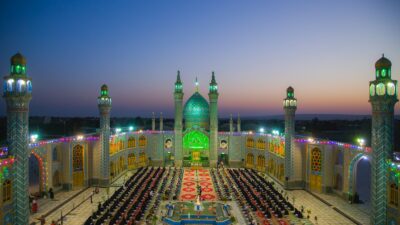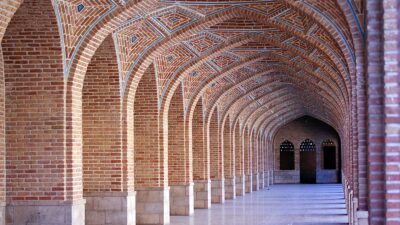Introduction
In this article we examine the history of early Shī‘īsm during the ‘Abbāsid period. This covers the period from Ja‘far al-Sādiq (d.765/148) to the death of the eleventh Imam Ḥasan al-‘Askarī. Politically, this period covers the first half of the reign of the second caliph, Abū Ja‘far al-Manṣūr to the first few years of the reign of al-Mu‘tamid. This period witnessed the first Abbāsid civil war, the move of the capital to Sāmarrā and the subsequent ‘anarchy’ at Sāmarrā. It also covers the deaths of the sixth to eleventh Imams (Ja‘far al-S̩ādiq to Ḥasan al-‘Askarī) and the deaths of the eponyms of the four Sunnī madhhabs.
The Abbasid challenge
By claiming the Imāmate based upon divine designation and upon descent from ‘Abbās, the ‘Abbasids were in fact directly challenging the early Shī‘īs on their own ground. Although not everyone was happy with the outcome of the revolution, a number of groups were appeased. These included the mawālī (non-Arab converts) and the religious opponents of the Umayyads from both the early Shī‘ī and Sunnī sides, with some of the early Shī‘īs moving into the Sunnī camp. The outcome of this was that the early Shī‘a had to formulate and consolidate’ their beliefs in response to this new, almost existential threat. The main opposition to the ‘Abbāsid claim were the Kūfan ‘Alids1. Among the early Shī‘a who supported the ‘Abbāsids were the Kaysānī (followers of Abū Hāshim) and some of the Zaydīs.
The Imāmate doctrine
It is in this period that we see the birth and development of the Imāmate doctrine. The first known exposition of the Imāmate doctrine was around 184/800 by ‘Alī b. Mītham. He stated that ‘Alī was more deserving of the Caliphate than Abū Bakr and as such the Muslims were mistaken in giving precedence to Abū Bakr and ‘Umar over ‘Alī. However, he does not mention the existence of the Imāms after ‘Alī. This is significant as it shows that at this stage, the early Shī‘as were not agreed upon a particular line of Imāms. Furthermore, in the presence of rival claims to leadership of the ‘Alīds, many people were not necessarily committed to one claimant or the other.
Ja‘far aṣ- S̩ādiq
Ja‘far aṣ- S̩ādiq witnessed, but did not take part in the ‘Abbāsid revolution. He also lived through the anti-Umayyad revolts of Zayd b. ‘Alī, ‘Abdallāh ibn Mu‘āwiya as well as the anti-‘Abbāsid revolt of Muh̩ammad al-Nafs al-Zakiyya. The revolt of Muh̩ammad an-Nafs az-Zakiyya in 145/762 in Madina was supported by his brother Ibrahim who rebelled in Bas̩ra. However, both rebellions were quickly defeated.
Muh̩ammad an-Nafs az-Zakiyyawas, and still is, held in high esteem by both Sunnīs and Shī‘īs, and among his thousands of students were the renowned Sunnī scholars Abū Hanīfa and Mālik b. Anas. He openly refuted some followers who held extreme beliefs, including a certain Abū ’l-Khaṭṭāb, who was executed in 138/755. Abū’l Khaṭṭāb attributed divinity to as-S̩ādiq. He also rejected common religious observances such as the prayer. Another follower of al-S̩ādiq was Hishām b. al-Ḥakam, was repudiated by al-S̩ādiq for his ghuluww beliefs. These beliefs included attributing a three-dimensional body to God, claiming that God did not know about an event before its occurrence and that parts of the Quran had been distorted.
The descendants of Ja‘far al-S̩ādiq
I will now briefly discuss those descendants of Ja‘far al-S̩ādiq who were later to become known as the seventh to eleventh Imāms by the Ithnā ‘Ashariyya (the Twelvers).
The death of an Imām often led to disputes and factionalism regarding the identity of his true heir. Usually the argument was either that the deceased Imām had not really died but was in concealment, or raised to heaven to return back to fill the earth with justice, or that he had been succeeded by one of his descendants (although by whom was another area of contention). Some of the sub-sects held extreme beliefs such as the divinity of the Imām. The most significant of these splits occurred after the death of Ja‘far al-S̩ādiq in 148 /765 during the reign of the second ‘Abbāsid caliph al-Manṣūr (r. 136–158 / 754–775). Approximately six splinter groups arose, eventually crystallising into two groups. The first group believed in the Imāmate ended with his son Ismā‘īl (d. 158 /755), who would return as the Mahdī and were later to be known as the Ismā‘īlīs.
Mūsā al-Kāzim
The second group were those who believed that the Imāmate was transferred to his son Mūsā al-Kāzim (d. 183/799)and were later known as the Ithnā ‘Ashariyya. However this second group was one of many groups of known existence at the time, and it was not then considered to be normative. Mūsā al-Kāẓim lived during the reigns of al Manṣūr, al-Mahdī and al-Rashīd, and it was during the reign of the latter that the persecution of the ‘Alīds increased, although at the same time, the following of Mūsā amongst the ‘Alīds increased.
‘Alī al-Rid̩ā
Mūsā’s son, ‘Alī al-Rid̩ā (d. 203/ 818), lived during the civil war between al-Ma’mūn and al-Amīn. A number of early Shī‘as used the unrest to launch their own uprising, capturing parts of the Hijaz, Yemen and Iraq. After Ma’mūn’s unexpected victory, he surprised both friend and foe by nominating ‘Alī al-Rid̩ā as his heir-apparent. He also announced, in opposition to the prevalent Sunnī view, that ‘Alī was the best person after the Prophet. This caused a backlash amongst the ‘Abbāsids, whose very legitimacy to rule was based upon their claim that they were more entitled to rule than the ‘Alids, and in response they set up a rival claimant to the caliphate in Baghdad. The controversy was solved by the sudden, some say suspicious, death of ‘Alī al-Rid̩ā.
The Shī‘a and many Muslim historians consider that he was poisoned. As for Ma’mūm’s motive for appointing an ‘Alid, there are a number of theories: it was to placate the various Shī‘ī rebellions taking place at the time in Kūfa, Mecca, Medina, and Yemen; it was due to Ma’mūm’s personal Shī‘ī convictions; or that he believed that the end of the world was close and he wanted to return to the ‘Alids that which was due to them. The modern day ‘Alawites are descended from the followers of Muh̩ammad ibn Nuṣayr an-Namīrī, who considered ‘Alī ibn Hādī to be God.
Muh̩ammad al-Taqī and ‘Alī al-Hādī
‘Alī al-Rid̩ā’s son, Muh̩ammad al-Taqī (d.220 / 835), was only a child when his father died. Other than his marriage to al-Ma’mūn’s daughter, which could be seen as a corollary of al-Ma’mūn’s pro-‘Alīd policy, his life was apparently uneventful. His son ‘Alī al-Hādī (d.254 / 868) was also a child when his father died2. The ascension of al-Mutawakkil as caliph in 232/847 witnessed a persecution of both Shī‘as and Mu‘tazila.[23] Both ‘Alī al-Hādī and his son Ḥasan (d. 260 /874) were virtual prisoners of the caliphs in the army quarters of Sāmarrā, and hence were called the two ‘Askarīs.
Ḥasan al-‘Askarī (the eleventh Imam)
Ḥasan al-‘Askarī lived during the anarchy at Sāmarrā and the rise of the Turkish military. His death led to a period known as the ḥayra (confusion), as at the time of his death there was doubt as to whether he had left a male heir. The early Shī‘a split into many sub-sects, with estimates ranging from between fourteen to twenty. Those who pledged allegiance to Ḥasan’s brother Ja‘far insisted that Ḥasan had died childless, and formed one of the largest sub-sects. The group that was to prevail, however, believed that Ḥasan al-‘Askarī had really died and left behind a son, Muhammad, who had gone into occultation.
Conclusion
What were the beliefs of the early Shī‘a around the 880s (i.e. just after the death of the eleventh Imām)? Some scholars, such as the Mu‘tazilī al-Kayyāṭ, and al-‘Ash‘arī who wrote shortly after the death of the eleventh Imām, state that the Shī‘a held anthropomorphic views with respect to God, believed in badā (alteration of God’s Will) and the alteration of the Quran. Badā refers to a change in God’s will. This belief was first articulated by Mukhtār al-Thaqafi after his promised victory did not transpire. According to this belief, although God may decree a matter to occur at a particular moment, He may change his mind due to some expediency. Another example of the usage of this term is the argument of Ithnā ‘Ashariyya that although Ismā‘īl was decreed to succeed his father Ja‘far, his brother Mūsā actually succeeded him due to badā.
However, the idea of the divinity of the Imāms was not common at this stage in the view of al-Kayyāt and al-‘Ash‘arī. According to Momen, the beliefs of the early Shī‘a at this stage was diametrically opposed to what was to be later known as Imāmi Ithnā ‘Ashariyya Shī‘īsm. In addition, the concept of the ghayba (occultation) of the twelfth Imām, or fixing the number of Imāms at twelve was, at this time, not universally accepted. The Shi’i author Muh̩ammad al-Nu‘mānī (d.360/971) stated that many of the Shī‘ī of his time ‘were uncertain as to the identity of the Imām and had doubts as to his occultation’.
Notes
- This explains why Abū Salama, who was the ‘Abbāsid representative in Kūfa, preferred an ‘Alid to be the future ‘Abbāsid Caliph. His plans were thwarted by the Khurāsāni Abū Muslim. ↩︎
- Which raised the problem of a non-pubescent Imām. ↩︎
References
Andrew J. Newman. Twelver Shiism Unity and Diversity in the Life of Islam, 632 to 1722 (2013)
Buhl, F., “Muḥammad b. ʿAbd Allāh b. al-Ḥasan al-Mut̲h̲annā b. al-Ḥasan b. ʿAlī b. Abī Ṭālib, called al-Nafs al-Zakiyya”, in: Encyclopaedia of Islam, Second Edition
Christopher Melchert, Ahmad Ibn Hanbal, (Oneworld Publications, 2012)
Goldziher, I. and Tritton, A.S., “Badāʾ”, in: Encyclopaedia of Islam, Second Edition
Halm, H, Shi’ism (Edinburgh University Press, 2004)
Jonathan Porter Berkey, The Formation of Islam: Religion and Society in the near East, 600-1800, (Cambridge University Press, 2003), p. 104.
Michael Cooperson Al-Ma’mun (Makers of the Muslim World) (2012)
Moojan Momen, An Introduction to Shiʻi Islam, The History and Doctrines of Twelver Shiʻism (1985)
W. Montgomery Watt. The Formative Period of Islamic Thought (1988)





